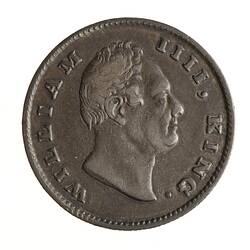Summary
2 Mohurs, 1835
Issued by East India Company, India, from 1 January 1836
Minted by Calcutta Mint
Obverse Description
Bare head of the King facing right; around, 'WILLIAM IIII, KING. 1835.'; incuse on neck truncation, 'R.S.' (for the mint master, Robert Saunders).
Reverse Description
A lion advancing to left in front of a palm tree; around above, EAST INDIA COMPANY; in exergue, TWO MOHURS and a line in Persian script (Do Ashrafi, translation: two mohurs)
Edge Description
Milled (vertical)
Significance
From as early as 1806 the East India Company had hoped to achieve a single currency for all of its Indian Presidencies. This was achieved in 1833 when the rupees of Bengal moved into line with those of Madras and Bombay. After some experimentation in 1834 by Act XVII of 17 August 1835 the Company moved forward towards a uniform coinage, not only of weight standard but also of design. Under the new system the silver rupee was legal tender. The gold double mohur and mohur coins, although initially passing at 30 and 15 rupees, were to float in terms of the rupee according to the metal market. The gold coins were not legal tender. Production at Calcutta began in 1835 and continued into 1836 (with the date frozen). However the relative value of gold and silver at that time meant the the mint made a loss on gold coin production so little occurred. Late strikes for collectors occurred perhaps till as late as 1970. This coin was acquired for the collection in December 1929.
Legislation:
A.D. 1835 ACT XVII
PASSED by the Honourable the Governor-General of India in Council on 17th August, 1835
(Note: the first six paragraphs relate to the silver rupee dated 1835 and its fractions and are recorded in the database under those denominations)
VII. And be it enacted, that the undermentioned gold coins only shall henceforth be coined at the mints within the territories of the East-India Company.
First. A gold mohur or 15 rupee piece, of the weight of 180 grains troy, and of the following standard: 11/12 or 165 grains of pure goold 1/12 or 15 grains of alloy.
Second. A five-rupee piece, equal to a third of a gold mohur.
Third. Aten-rupee piece, equal to two-thirds of a gold mohur
Fourth. a 30-rupee piece, or double gold mohur; and the three last mentioned coins shall be of the same standard with the gold mohur and of proportional weight.
VIII. And be it enacted, that these gold coins shall bear on the obverse the head and name of the REIGNING sovereign of the United Kingdom of Great Britain and Ireland, andon the reverse the designation of the coin ijn English and Persian, and the words "East-India Company" in English, with such embellishment as shall from time to time be ordered by the Governor-General in Council, which shall always be different from that of the silver coinage.
IX. And be it enacted, that no gold coin shall henceforth be a legal tender of payment in any of the territories of the East-India Company.
X. And be it enacted, that it shall be competent to the Governor-General in Council, in his executive capacity, to direct the coining and issue of all coins authorised by this Act; to prescribe the devices and inscriptions of the copper coin issued from mints in the said territories, and establish, regulate, and abolish mints, any law hitherto in force to the contrary notwithstanding.
More Information
-
Collecting Areas
-
Acquisition Information
Transfer from National Gallery of Victoria (NGV), 15 Mar 1976
-
Date Issued
1835 AD
-
Issued By
-
Mint
-
Other Association (See Comments)
Robert Saunders - Calcutta (Mint), India, 1835-1836
Mint master whose initials occur on this coin -
Denomination
-
Series
-
Material
Gold
-
Axis
12
-
Classification
-
Category
-
Discipline
-
Type of item
-
Dimensions
33 mm (Outside Diameter), 23.283 g (Weight)
-
Shape
Round
-
References
Pridmore 1 KM#452.1
[Book] Bruce, Colin R. 2006. Standard Catalogue of World Coins 1801 - 1900.
[Book] Pridmore, Fred. 1975. The Coins of the British Commonwealth of Nations, Part 4, India. 1., Vol.2 p. 26 Pages
-
Keywords
British Commonwealth Coins, British Commonwealth and Empire Coins






